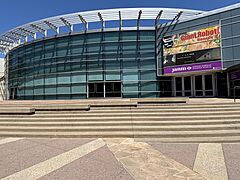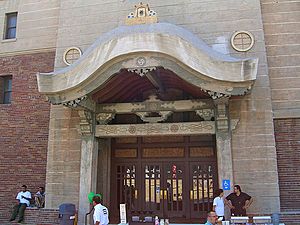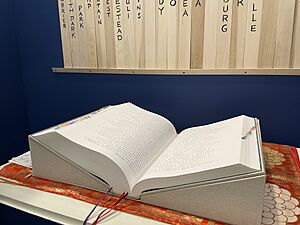Japanese American National Museum facts for kids
 |
|

Museum in August 2024
|
|
| Established | 1992 |
|---|---|
| Location | Little Tokyo, Los Angeles, California |
| Type | History and culture of Japanese Americans |
| Public transit access | |
The Japanese American National Museum (also called JANM) is a special place in Los Angeles, California. It helps keep alive the history and culture of Japanese Americans. The museum opened in 1992 and is located in the Little Tokyo area, which is close to downtown Los Angeles. It is also connected to the Smithsonian Affiliations program, which means it works with the famous Smithsonian museums.
The museum shares stories from over 130 years of Japanese American history. This includes the first generation of immigrants, called Issei. The museum has a huge collection of old home movies, more than 100,000 feet of film! These films show what life was like for Japanese Americans from the 1920s to the 1950s. It also has many other items like old clothes, art, photos, and recorded interviews (called oral histories) from Japanese Americans. The museum works with the Academy Film Archive to take care of these home movies and let people see them.
Contents
Museum History
A person named Bruce Teruo Kaji (1926–2017) was a very important leader who helped start the museum. He worked with other Japanese Americans to create it. The community wanted to make sure that the unfair treatment they faced from the government during World War II was remembered.
The museum was created to show all the good parts of their history and culture in the United States. When it first opened in 1992, the museum was in an old Buddhist temple building from 1925. This temple building was actually used by government officials in 1942 to process Japanese Americans for wartime confinement. Now, it is used for offices and storage.
Irene Hirano was the first person to lead the museum as its executive director and later as its president. In January 1999, the museum opened its current, much larger building. This new building is about 85,000 square feet and was designed by architect Gyo Obata.
Important Collections and Centers
In 1993, the museum received hundreds of items and letters from children who were in internment camps during World War II. These were sent to a librarian named Clara Breed. The museum created an exhibit called "Dear Miss Breed": Letters from Camp to share these important stories. These items are now a permanent part of the museum's collection.
In 1997, the Frank H. Watase Media Arts Center was started. It helps find new ways to record and share the experiences of Japanese Americans. Then, in 1999, the Manabi and Sumi Hirasaki National Resource Center (HNRC) was created. This center helps people find information and resources about Japanese American life and culture, both at the museum and online.
Akemi Kikumura Yano, an author, was the museum's first curator. She later became the president and CEO from 2008 to 2011. During her time, in December 2010, the museum received a special award called the National Medal for Museum and Library Service.
Recent Leadership and Challenges
Rev. Greg Kimura was the museum's president and CEO from 2012 to 2016. After him, Ann Burroughs became the interim CEO in 2016 and was later officially chosen for the role. She said she wanted to help the museum continue to teach people about democracy and the importance of different cultures.
The museum has faced challenges, including a cut in funding from the U.S. government. This happened because the museum chose not to change its programs that support diversity, equity, and inclusion. William T. Fujioka, who leads the museum's board of trustees, said that it's even more important now to share their story and support other groups who are facing unfair treatment. He mentioned that this reminds them of what happened to the Japanese American community in 1942.
Museum Exhibits
The museum has several ongoing exhibits that visitors can explore.
- The Interactive StoryFile of Lawson Iichiro Sakai is a special exhibit where you can ask questions to Lawson Sakai, and he answers them! He has answered thousands of questions about his life and experiences.
- Common Ground: The Heart of Community tells the story of 130 years of Japanese American history. It covers everything from the first immigrants to the United States, the World War II incarceration, and up to today.
- Wakaji Matsumoto—An Artist in Two Worlds: Los Angeles and Hiroshima, 1917–1944 is an online exhibit. It shows photographs of the Japanese American community in Los Angeles before World War II. It also shows pictures of city life in Hiroshima before the 1945 atomic bombing of the city.
Past Exhibitions
The museum has also hosted many interesting temporary exhibits over the years. Some of these have included:
- Glenn Kaino: Aki’s Market (June 2023 - January 2024)
- Don't fence me in: Coming of Age in America’s Concentration Camps (March - October 2023)
- Sutra and Bible: Faith and the Japanese American World War II Incarceration (February 2022 - February 2023)
- BeHere / 1942: A New Lens on the Japanese American Incarceration (May 2022 - January 2023)
- Miné Okubo's Masterpiece: The Art of Citizen 13660 (August 2021 - March 2022)
- A Life In Pieces: The Diary and Letters of Stanley Hayami (July 2021 - January 2022)
- Under a Mushroom Cloud: Hiroshima, Nagasaki, and the Atomic Bomb (November 2019 - July 2021)
- Taiji Terasaki: Transcendients (February 2020 - May 2021)
- At First Light (May - October 2019)
- Kaiju Vs. Heroes (September 2018 - July 2019)
- Gambatte! (November 2018 - April 2019)
- hapa.me: 15 years of the hapa project (April - October 2018)
- What We Carried (May - August 2018)
- Transpacific Borderlands: The Art of the Japanese Diaspora in Lima, Los Angeles, Mexico City, and Saõ Paulo (September 2017 - February 2018)
- New Frontiers: The Many Worlds of George Takei (March - August 2017)
- Instructions to All Persons: Reflections on Executive Order 9066 (February - August 2017)
- Tatau: Marks of Polynesia (July 2016 - January 2017)
- Uprooted: Japanese American Farm Labor Camps During World War II (September 2016 - January 2017)
- Above the Fold: New Expressions in Origami (May - August 2016)
- Making Waves: Japanese American Photography 1920-1940 (February - June 2016)
- Hello! Exploring the Supercute World of Hello Kitty (October 2014 - May 2015)
- Two Views: Photographs by Ansel Adams and Leonard Frank (February - April 2016)
- Giant Robot Biennale 4 (October 2015 - January 2016)
- Before They Were Heroes: Sus Ito's World War II Images (July - September 2015)
- Sugar/ Islands: Finding Okinawa in Hawai'i - The Art of Laura Kina and Emily Hanako Momohara (July - September 2015)
- Dodgers: Brotherhood of the Game (March - September 2014)
- Perseverance: Japanese Tattoo Tradition in a Modern World (March - September 2014)
- Marvels & Monsters: Unmasking Asian Images in U.S. Comics, 1942-1986 (October 2013 - February 2014)
- Folding Paper: The Infinite Possibilities of Origami (March - August 2012)
- Drawing the Line: Japanese American Art, Design & Activism in Post-War Los Angeles (October 2011 – February 2012)
- Year of the Rabbit: Stan Sakai's Usagi Yojimbo (July - October 2011)
- No Victory Ever Stays Won: The ACLU's 90 Years of Protecting Liberty (November - December 2010)
- Mixed: Portraits of Multiracial Kids by Kip Fulbeck (March - October 2010)
- 20 Years Ago Today: Supporting Visual Artists in L.A. (October 2008 - January 2009)
- Glorious Excess (Born): Paintings by Linkin Park's Mike Shinoda (July - August 2008)
- Living Flowers: Ikebana and Contemporary Art (June - September 2008)
- Southern California Gardeners' Federation: Fifty Years (October - November 2005)
- Boyle Heights: The Power of Place (September 2002 – February 2003)
- Sumo U.S.A.: Wrestling the Grand Tradition (July - November 1997)
- Dear Miss Breed: Letters from Camp (January - April 1997)
Major Projects
One very important project finished in 2022 is the Ireichō. This is the first complete list of over 125,000 people of Japanese background who were held in camps by the U.S. government during World War II. A physical book of these names is at the museum. People can visit to honor those listed and even correct any information if needed.
Another project is Discover Nikkei. This is an online resource available in many languages. It shares stories, old photos, and research about the global Japanese community (Nikkei). The museum's International Nikkei Research Project also created a book called New Worlds, New Lives in 2002.
Museum Leadership
Ann Burroughs is currently the President and Chief Executive Officer of the museum.
The museum's board of trustees includes important people like former Los Angeles County Chief Executive Officer William T. Fujioka and actor George Takei. George Takei has supported the museum on TV shows like The Celebrity Apprentice and The Newlywed Game.
Images for kids
See Also
- Go for Broke Monument - a monument nearby
- History of the Japanese in Los Angeles
- Historic Wintersburg in Huntington Beach, California
- Japanese American Citizens League
- Japanese American National Library
- Japanese American Museum of San Jose
- Japanese Cultural Center of Hawaii
- Densho: The Japanese American Legacy Project
- Japanese American Committee for Democracy
- U.S.-Japan Council






